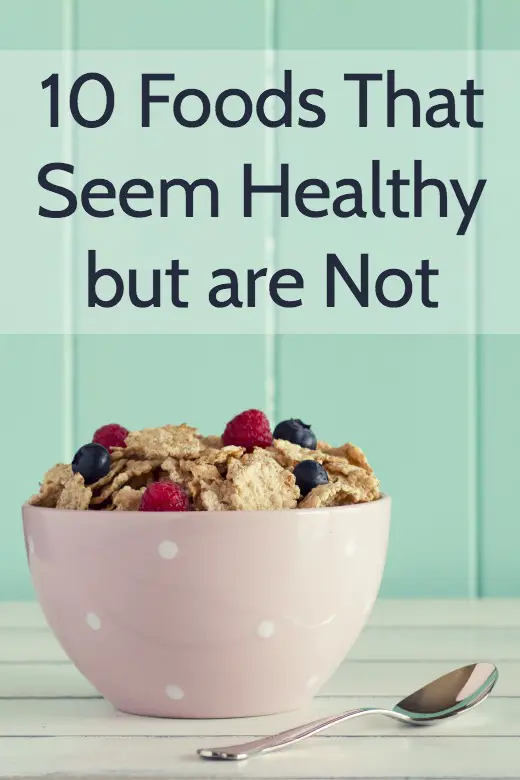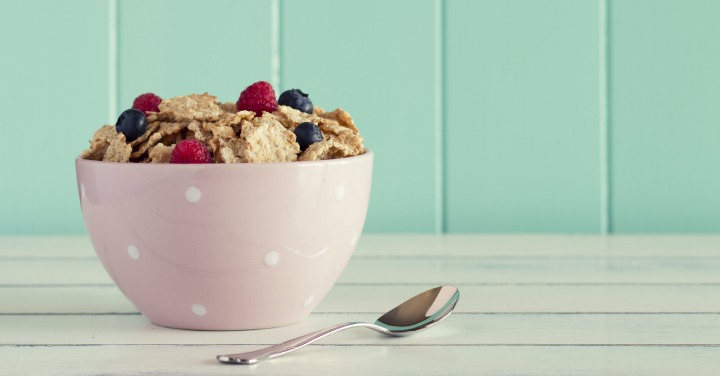10 Foods That Seem Healthy but are Not
When marketers are allowed to make claims about food without scientific research to back it up, there can be so much confusion as to what is healthy and what is not. Below are the top 10 foods that you probably think are health but are not!
1. Fruit Juice
Fruit juice may be delicious, but it is often loaded with even more high-fructose corn syrup than actual juice! High fructose corn syrup has been linked to increased cholesterol levels, diabetes, cellular damage, blood clots and impaired immunity.
Fructose on it’s own is only healthy in small amounts and when consumed with its whole fruits. Large amounts of fructose reduce the affinity of insulin for its receptor, which is the hallmark of type-2 diabetes. And because this is the first step for glucose to enter a cell and be metabolized. As a result, the body needs to pump out more insulin to handle the same amount of glucose.
The American Association for the Study of Liver Diseases reports a link between high intake of sugar (specifically fructose) to liver disease. Their research concludes that consumption of high fructose can have negative effects on liver through overfeeding, as well as damage the liver by inducing increased oxidative stress.
 2. Whole Grains
2. Whole Grains
Many foods from bread to breakfast cereals advertise that they are now made with whole grains. Fiber in food is key to health, but in the form of whole grains can be problematic.
If you have digestive problems or suffer from autoimmune disease (e.g. allergies, arthritis, skin disorders, digestive disorders) consider the possibilities that grains may be causing you trouble.
Conventional whole grains lack vitamins and minerals, can be difficult to digest, and cause systemic inflammation.
A better alternative? Fiber can be consumed in the form of whole vegetables and fruits instead of grains.
For a detailed breakdown on why whole grains are troublesome, see The Paleo Cure by Chris Kresser.
3. Processed Cheese
Processed cheeses, especially individually wrapped slices, have little nutritional value. They are pasteurized and often full of fillers and preservatives.
4. Protein Bars
Protein bars now compete with candy bars in convenience stores and grocery aisles, but the protein in these quick snacks are not necessarily healthy. Not all protein bars are bad, but many are!
Many protein bars use soy protein and count sugars in their top 3 ingredients, contributing to hormone disruption and fungal infections.
5. Pasteurized Milk
Milk is touted as a healthy food, and most people assume that it does a body good. But pasteurization destroys active enzymes and denatures the fragile proteins in milk. It also kills beneficial bacteria and lowers the vitamin content of your milk.
A better alternative? Raw milk is milk that has not been pasteurized. Why raw milk? Supporters of raw milk say the pasteurization process kills most, if not all, micromilk organisms, including the beneficial ones that aid in digestion and metabolization. These organisms also promote good health by crowding out bad bacteria and help prevent yeast overgrowth in the intestinal tract.
The Campaign for Raw Milk also says that pasteurization destroys enzymes and diminishes vitamin content. Pasteurization, says the group, is associated with allergies, increased tooth decay, colic in infants, growth problems, osteoporosis, arthritis, heart disease and cancer. Many calves fed pasteurized milk die before maturity.
Raw milk will sour naturally due to the bacterial production of lactic acid and still be healthy, while pasteurized milk, which lacks the essential bacteria, will putrefy.
If you’re not comfortable consuming raw milk, it is important to select milk products that are from cows that are grass-fed. This provides you with important nutrients that are lower in non-grass-fed cows. Non-grass-fed cows also live in less-healthy conditions.
6. Cereal
Cold cereal seems like a convenient and healthy meal, but combined with pasteurized milk, it can be a bowl full of nutritionally damaging food.
Cereal itself undergoes a process called extrusion that denatures its proteins (making them toxic) and destroys the grains’ naturally occurring fatty acids. The result is a nutritionally void carrier for sugar.
In one study, rats fed a strict diet of only cereal grains died after just weeks of consumption.
Further, dried fruits found in cereal contain alarmingly high amounts of sugar.
A better alternative? Make your morning meal smooth and/or green!
A great blend for morning shakes is JJ Virgin Shakes.
7. Energy Drinks
Their labels say they contain various herbs, minerals and amino acids, specially designed to boost your energy by the time you reach the bottom of the can. But if you look at the ingredients, you will find that the main ingredients in most energy drinks are actually caffeine and sugar making them hardly more than high-priced soft drinks.
Ignore their glitzy designs and claims to improve your performance, concentration and reaction speeds seem to be working.
A better alternative? Water! And if you must have a jolt of energy, a single old-fashioned cup of coffee, black, with grass-fed milk or coconut milk is better.
8. Fast-Food Salads
Yes, you went to that fast-food joint near your office for lunch, but all was not lost because you ordered a salad! Wrong!
Most fast-food chains have jumped on the health bandwagon and are offer salads, wraps and other so-called healthy menu choices for just such nutrition-minded customers.
But all salad is not inherently healthy.
In fact, most of the salad ingredients that most fast food chains use make most of them no more healthful than a burger without the bun, dipped in salad dressing, said the Physicians Committee for Responsible Medicine (PCRM), which conducted a nutrition analysis of 34 fast food salads.
Iceberg lettuce offers just about no nutritional value and the salad dressings offered are always made with industrial vegetable and seed oils (ie, soybean oil, safflower oil, canola oil, sunflower oil) making them dangerously high in Omega 6 oils that oxidize and damage the cells in our bodies.
Many fast-food salads also have high amounts of added sugar.
9. Soy Products
Soy products, including soy milk and soy protein have been linked to digestive distress, immune system breakdown, PMS, endometriosis, reproductive problems for men and women, allergies, ADD, higher risk of heart disease and cancer, malnutrition and loss of libido.
Soy milk has some negative aspects which are as follows:
- It is a hormone disrupter.
- It causes cellular damage.
- It contains a lot of phytic acid.
- The genetic modification involved in the process of preparing soy milk wreaks havoc on your system.
- It often contains aluminum.
- It contains trypsin inhibitors.
A better alternative? The only soy that is okay for consumption is non-gmo fermented soy products like miso soup, natto and tempeh and even then, should be consumed only in strict moderation.
10. Oatmeal
For many people who suffer wheat and gluten allergy or intolerance, oatmeal also becomes and unsafe option. While oats themselves do not contain gluten, they do contain a protein which is relatively similar and current farming techniques create concerns as well. It is not uncommon for a farmer to rotate his oat crops with his wheat, rye or barley crops from year to year, and millers often encounter kernels from volunteer wheat when processing the oats.
Oatmeal seems harmless enough and does not actually contain gluten. But oatmeal can be unsafe if you have a wheat or gluten sensitivity because farmers often grow oats in fields that previously had grains like barley and wheat. The other grains can contaminate the oats and could be dangerous for anyone with gluten sensitivity.
Further, oatmeal falls in the category of Whole Grains above making it an unhealthy choice!
